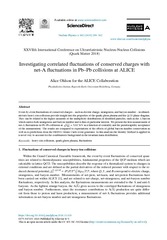Investigating correlated fluctuations of conserved charges with net-Λ fluctuations in Pb–Pb collisions at ALICE
Ohlson, Alice; Acharya, Shreyasi; Acosta, Fernando T.; Adamová, Dagmar; Adolfsson, Jonatan; Aggarwal, Madan M.; Aglieri Rinella, Gianluca; Agnello, Michelangelo; Agrawal, Neelima; Ahammed, Zubayer; Alme, Johan; Altenkaemper, Lucas; Djuvsland, Øystein; Ersdal, Magnus Rentsch; Fionda, Fiorella Maria Celeste; Nystrand, Joakim; Rehman, Attiq Ur; Røhrich, Dieter; Tambave, Ganesh Jagannath; Ullaland, Kjetil; Wagner, Boris; Zhou, Zhuo; Arsene, Ionut Cristian; Bätzing, Paul Christoph; Dordic, Olja; Lardeux, Antoine Xavier; Lindal, Svein; Mahmood, Sohail Musa; Malik, Qasim Waheed; Richter, Matthias; Røed, Ketil; Skaali, Toralf Bernhard; Tveter, Trine Spedstad; Wikne, Jon Christopher; Zhao, Chengxin; Helstrup, Håvard; Hetland, Kristin Fanebust; Kileng, Bjarte; Nesbø, Simon Voigt; Storetvedt, Maksim Melnik; Langøy, Rune; Lien, Jørgen André; Ahn, Sang Un; Aiola, Salvatore; Akindinov, Alexander; Al-Turany, Mohammad; Alam, Sk Noor; Albuquerque, D. S. D.; Aleksandrov, Dmitry; Alessandro, Bruno; ALICE, Collaboration
Peer reviewed, Journal article
Published version

Åpne
Permanent lenke
https://hdl.handle.net/1956/23740Utgivelsesdato
2019Metadata
Vis full innførselSamlinger
Originalversjon
https://doi.org/10.1016/j.nuclphysa.2018.11.020Sammendrag
Event-by-event fluctuations of conserved charges – such as electric charge, strangeness, and baryon number – in ultrarelativistic heavy-ion collisions provide insight into the properties of the quark-gluon plasma and the QCD phase diagram. They can be related to the higher moments of the multiplicity distributions of identified particles, such as the Λ baryon which carries both strangeness and baryon number and is thus of particular interest. We present the first measurement of net-Λ fluctuations in Pb–Pb collisions at √sNN = 5.02 TeV as a function of centrality and the pseudorapidity acceptance of the measurement. The results are compared to expectations of the effects of global baryon number conservation as well as to predictions from the HIJING Monte Carlo event generator. In this analysis the Identity Method is applied in a novel way to account for the combinatoric background in the invariant mass distribution.
